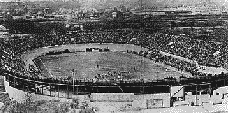The 1920s in America were known as the "Roaring Twenties." But for the National Football League, that 10-year period could be remembered more accurately as the "Tempestuous Twenties."
A major problem with the early-day NFL was that its member teams were primarily situated in small cities which were unable to generate enough fan support to make the teams financially successful.
Teams like the Kenosha Maroons, Racine Legion, Rochester Jeffersons and Canton Bulldogs all at one time were in the NFL. While most small-city teams faced financial failure, some, like the Canton Bulldogs, were winners on the field. The Bulldogs won back-to-back NFL titles in 1922 and 1923.
Several other now-defunct 1920s. One such team was the Providence Steam Roller, which in 1928 became the last team not now in the NFL to capture a league title. Though organized in 1916, the Steam Roller did not join the NFL until 1925. In the next seven years, the team not only won a championship but also established three NFL "firsts."
Providence was the first NFL team to play its home games in a bicycle racing stadium; first to host an NFL game at night under floodlights; and the first to play four regular-season games in six days.
The Steam Roller's home field was the 10,000 seat Cyclodome, which had been built in 1925 by a sports promoter and part-owner of the team, Pete Laudati. Since the Cyclodome's primary function was to serve as a racing stadium, the fct teams enjoyed their "moments in the sun" in football field was snugly surrounded by a wooden track with steeply-banked ends, which cut sharply into the end zones and reduced them to just five yards in depth. On game day, temporary seating was permitted on the straight-away portion of the track, which was so close to the field that players, after being tackled, often found themselves two or three rows deep in the stands.

The year following their 1928 championship, the Steam Roller established two more NFL "firsts." In the six-day period between November 5 and November 10, 1929, Providence played four games. The marathon string began against the Staten Island Stapletons, continued against the Chicago Cardinals and concluded with a two-game series against the Frankford Yellow Jackets. Although the Steam Roller made history, their 0-3-1 record for the six-day stretch proved the folly of their scheduling.
The Steam Roller's other "first" occurred during the second game of that four-game fiasco. When Providence hosted the Cardinals on November 6, the game was played at night at nearby Kinsley Park Stadium, where floodlights recently had been installed. The teams had originally been scheduled to play on Sunday, November 3, but heavy rains made the Cyclodome field unplayable. Since neither team wanted to lose a payday, the historic night game was hastily scheduled.
Although the Steam Roller lost 16-0, the game was declared a success because 6,000 fans attended. The local newspaper reported that the ball, which had been painted white for the night game, "had the appearance of a large egg," and whenever either team passed, "there was a panicky feeling that the player who made the catch would be splattered with yellow yolk." The "monster floodlights," the newspaper concluded was "just as good as daylight for the players." The next year, floodlights were permanently installed in the Cyclodome.
While night football did not become an immediate rage in the NFL, the innovation did affect at least one Providence player directly. According to his 1930 contract which is now in the Hall of Fame archives, Tony Latone was paid $125 for all NFL daylight games and 60 percent of that sum for NFL "floodlight" games. Former team executive Pearce Johnson explained that the pay reduction for night games was arranged to help pay the installation costs of the floodlights.

